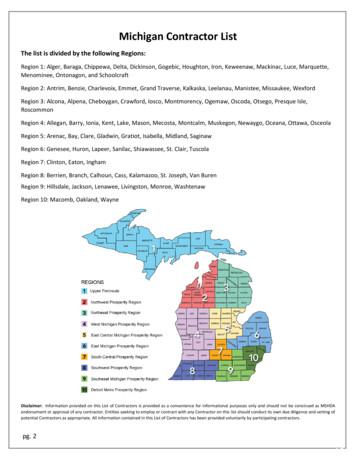Mechanical Properties Of Biomaterials
MechanicalProperties ofBiomaterialsAcademic Resource Center
Determining BiomaterialMechanical Properties Tensile and Shear properties Bending properties Time dependent properties
Tensile and Shear properties Types of forces that canbe applied to material:a)b)c)d)TensileCompressiveShearTorsion
Tensile Testing Force applied as tensile, compressive, or shear. Parameters measured: Engineering stress (σ) and Engineeringstrain (ԑ). σ F/A0 : Force applied perpendicular to the cross section ofsample ԑ (li-l0)/l0: l0 is the length of sample before loading, li is thelength during testing.
Compression Testing Performed mainly for biomaterials subjected to compressiveforces during operation. E.g. orthopedic implants. Stress and strain equations same as for tensile testing exceptforce is taken negative and l0 larger than li. Negative stress and strain obtained.
Shear Testing Forces parallel to top and bottom facesShear stress (τ) F/A0Shear strain (γ) tanθ ; θ is the deformation angle.In some cases, torsion forces may be applied to sampleinstead of pure shear.
Elastic Deformation Material 1: Ceramics Stress proportional tostrain. Governed by Hooke’slaw: σ ԑE; τ Gγ E :Young’s modulus G:Shear modulus - measureof material stiffness. Fracture after applyingsmall values of strain:ceramics are brittle innature.
Elastic and Plastic deformation. Material 2: Metal Stress proportionalto strain with smallstrain; elasticdeformation. At high strain, stressincreases very slowlywith increased strainfollowed by fracture:Plastic deformation.
Elastic and Plastic deformation. Material 3: Plasticdeformation polymer Stress proportionalto strain with smallstrain; elasticdeformation. At high strain, stressnearly independentof strain, shows slightincrease: Plasticdeformation.
Elastic and Plastic deformation. Material 4: Elasticpolymer Stress increases veryslowly withincreasing strain. Do not fracture at avery high strainvalues.
Plastic deformation Plastic deformation occursat point where Hook’s Lawis no longer valid, i.e. end ofelastic region. Stress at this point is calledyield strength (σy) and stainis called yield point strain(ԑyp). Further stress increaseswith strain up till amaximum point M, calledUltimate tensile strength(σuts). With further increase instrain, stress decreasesleading to Fracture.
Engineering vs. True Stressstrain True stress (σt) force divided by instantaneous area σt F/Ain True strain ԑt ln(li/l0)
Stages of Plastic Deformationa) Lamellar and amorphousregions of polymer interactin response to tensileforces.b) Stage 1: chains extend andlamella slide past eachother.c) Stage 2:Lamella re-orient sothat chain folds align alongthe axis of loading.
Stages of Plastic Deformationd) Stage 3: Blocks of crystallinephases separate, adjacentlamella still attached toeach other through tiemolecules.e) Stage 4: Finally blocks and tiemolecules become orientedalong the axis of appliedtensile forces.
Bending Properties Helps in calculation of: Stress required to fracture the sample or Modulus ofRupture (also called flexural strength).σmr 3FfL/2bd 2
Time Dependent Properties CREEP: Defined as plastic deformation of sample under constantload over time. Creep at 37 deg C a significant concern for biomedical applications. Failure of Polymer ligaments.
Creep Molecular Causes of creep: Metals: Grain boundary movement, vacancy diffusion Ceramics: little or no vacancy diffusion Polymers: viscous response in amorphous regions. Creep is function of crystallinity: As % crystallinity increases,creep decreases.
Creep curve 3 distinct regions: Primary creep: increase in strainwith time; creep rate decreases. Secondary creep: linear relationbetween creep strain and time. Tertiary creep: Leads to fracture.
Contact: BME Table, Academic Resource CenterQUESTIONS OR SUGGESTIONS?
Mechanical Properties Tensile and Shear properties Bending properties Time dependent properties . Tensile and Shear properties Types of forces that can be applied to material: a) Tensile b) Compressive c) Shear d) Torsion . Tensile
These nanomechanical properties of (G–R) 4 and GRG 5RG 4R largely mimic those of individual titin molecules. We then used these miniature-titin-like elastomeric proteins to construct biomaterials to mimic the passive mechanical properties of muscle. Individual titin molecules are well-aligned and organized in the filament lattice of muscle3 .
Introduction to Biomaterials Lecture No. Title Speaker Video Lecture Link Text Document Link Views 1 Introduction to basic concepts of Biomaterials Science; Salient properties of
Chapter One Introduction ١ Biomaterials Biomaterials are used to make devices to replace a part or a function of the body in safe, reliably economically, and physiologically acceptable manner. A variety of devices and
development of novel new-generation biomaterials with improved bioactivity and mechanical properties. Specifically, these new concepts and strategies for fab-rication methods and improved tissue in-teractions could lead to biomaterials that are truly biocompatible and bioresponsive at a nanoscale level, similar to biogenic (natural) materials.
and properties of materials A simple introduction to amorphous and crystalline structure was presented This was followed by some basic definitions of stress, strain & mechanical properties The mechanical properties of soft and hard tissue were then introduced Balance of mechanical properties is key for design.
Mechanical Contractor Redmon Heating & Cooling Grandville (616) 534-9330 Mechanical Contractor D.K.S. Mechanical, Inc. Marne (616) 677-6001 Mechanical Contractor AirFlow Mechanical Services LLC Wyoming (616) 752-0320 Mechanical Contractor Van Antwerp's Mechanical, Inc. Holland (616) 772-1112 Mechanical Contractor Grand Rapids Heating and .
Biomaterials from orange waste were shaped using only glycerol and orange waste powder. Mechanical characterisation and aerobic degradation studies were also performed in soil. In the meantime, solid state fermentation of wet and ground orange waste was also performed using the fungi Neurospora intermedia and Aspergillus oryzae, with the intention
Coaxial, Multi-Conductor, Paired & Speaker Cable 3 LEVELS OF SAVINGS NAME HOUSE BRANDS BRANDS SPECIAL BUY Wire & Cable 42 Order by Phone at 1-800-831-4242 or Online at www.Jameco.com Coaxial Cable † Color: black † PVC jacket † Polyethylene insulated























